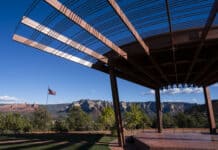This morning as I woke up in downtown Mexico City, I mean Beijing, I mean Los Angeles circa 1986 — it was hard to tell I still lived in Sedona considering I couldn’t see a single rock formation from any direction.
As I made the short drive from my house in West Sedona to the newsroom, I passed many of my neighbors on their morning walks. I wanted to shout that the Arizona Department of Environmental Quality has warned people not to go outside, but of course my windows were rolled up because I didn’t want to breathe the air. The kicker was seeing an out-of-state couple behind me at a stoplight wearing white facemasks.
Allowing lightning-caused wildfires to burn naturally makes sense, as it keeps forests healthy. But using wildfires as a forest-thinning management plan is moronic, if not outright dangerous. Permitting smoke to affect populated areas for weeks harms the health of residents, especially outdoor workers, recreationists and the elderly. It also turns public opinion against the U.S. Forest Service.
The Four Forest Restoration Initiative was supposed to alleviate these problems. Under the plan, the Kaibab, Coconino, Apache-Sitgreaves and Tonto national forests would reduce wildfire danger by having approved contractors thin small-diameter trees to produce wood products and biofuel on 2.4 million acres of overgrown ponderosa pine in Northern Arizona. The plan would have reduced fire risk, established an ecologically sustainable timber industry and prevented weeklong smoke inundations.
Delays and allegations of agency bias and incompetence plagued the project. The France-based firm the U.S. Forest Service first hired couldn’t get investors. The current firm, backed by the Sultanate of Oman, has worked throughout Africa but has no experience in the American West. Its contract permits it to thin 300,000 acres per year but has only touched a few thousand acres. Lawsuits by subcontractors and environmentalists have hampered efforts as well as insufficient equipment and a poor business plan.
 A healthy ponderosa pine forest is supposed to support 25 to 110 trees per acre, with the rest of the acreage covered by light brush and scrub. After decades of intense and immediate fire suppression efforts, our forests now support 400 and 1,000 trees per acre, so wildfires become firestorms that are impossible to manage.
A healthy ponderosa pine forest is supposed to support 25 to 110 trees per acre, with the rest of the acreage covered by light brush and scrub. After decades of intense and immediate fire suppression efforts, our forests now support 400 and 1,000 trees per acre, so wildfires become firestorms that are impossible to manage.
Ponderosa pines have evolved to endure light, occasional wildfires. Fire mulches the forest floor, giving pine seeds nutrients and clearing dead trees to provide space. But intense wildfires kill the seeds by raising soil temperatures above tolerances.
No one wants to see USFS lands denuded by heavy logging nor by massive, unstoppable wildfires.
If smoke drifts toward a heavily populated area, the USFS should contain and mitigate fire as soon as possible. These fires are scheduled to burn through mid-June, which is simply too long for too little benefit.
To lodge a complaint about the smoke, contact the Coconino National Forest Supervisor’s Office at (928) 527-3600 or coconino_webmail@fs.fed.us. We have also posted a link for readers to file a Smoke Impact Report complaint with the USFS on our website and Facebook page.
Christopher Fox Graham
Managing Editor


















